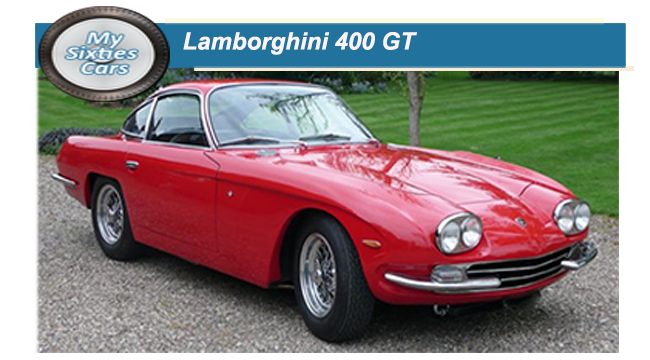
After the comparative success of their first model, the 350GT Lamborghini stepped up their performance a little by marketing its successor, the 400 GT as a 2+2, even though the two back seats were very small and none too comfortable.
Unveiled at the 1966 Geneva Auto Show, Lamborghini the 400GT 2+2, featured an extended steel body and a lengthened wheelbase to accommodate comfortable rear seats.
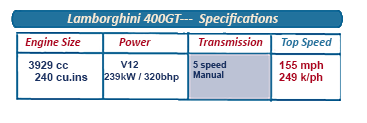 This development made the first-generation Lamborghini a convincing grand touring car, very much the type Ferruccio Lamborghini had set out to build when he established his car company.
This development made the first-generation Lamborghini a convincing grand touring car, very much the type Ferruccio Lamborghini had set out to build when he established his car company.
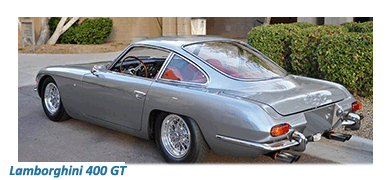 The 400 GT,powered by a four-cam 3929-cc V-12 engine, capable of generating produced 320 horsepower, virtually the same engine that would power Lamborghinis way into the Seventies.
The 400 GT,powered by a four-cam 3929-cc V-12 engine, capable of generating produced 320 horsepower, virtually the same engine that would power Lamborghinis way into the Seventies.
A new gearbox and final-drive unit were designed for Lamborghini by Gian Paolo Dallara.
Similar in basic appearance to the 350 GT, the 400 GT was a far departure in design, with two models sharing not a single body panel.
In addition, the 400GT came with quad round headlamps, while the car had a slightly higher roofline, some 60mm (2.5in) taller than the 350GT providing a little more in the way of passenger comfort.
Headlights apart, the 400GT 2+2 inherited the dashing looks of the 350GT, its deeper body even improving on them from some angles.
![]()
Beyond that, Touring released two version of the 350GTS convertibles, with the hood folding down into the space where the third seat had been.
Zagato buil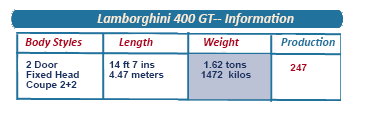 t a `350GTZ' coupe which distinctly echoed some of the bodies produced by the renowned coach builder on behalf of Ferrari.
t a `350GTZ' coupe which distinctly echoed some of the bodies produced by the renowned coach builder on behalf of Ferrari.
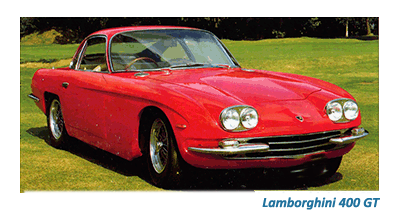
With an eye to begin moving in the direction of mass production at the Lamborghini plant at Sant'Agata in Bologna, the company decided to use steel instead of alloy for the construction of the body (although the boot lid and bonnet were still aluminium).
Ultimately, the car looked virtually the same as the 350GT, but with quad headlights and a suitably chopped fastback roofline.
To cope with the extra weight of the steel body, 150kg (3301b) more massive than the 350GT, the 400GT was given additional engine capacity, more torque, and more power.
![]()
The V12 engine, with its six twin-choke Weber carburettors, was very smooth, and top speed remained an impressive (but very noisy) 248km/h (155mph).
There was also a two-seater convertible offered, although very few were commissioned.
The interior of the regular 2+2 was comfortable, and there was little mechanical or airflow noise.
The fascia was not ideal, and some of the controls were heavy — Lamborghini shortcomings that would persist in later models.
Famous owners include Sir Paul McCartney, who personally imported an orange Lamborghini 400 GT into the UK in the summer of love in 1967 when The Beatles were the height of their success.
The following year it became obvious that Lamborghini's love for the 400G had faded when production was wound down, the model swiftly superseded by the Islero.
When Lamborghini gave the order to wind up production, a total of 247 400GTs had been produced.







